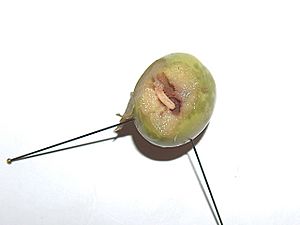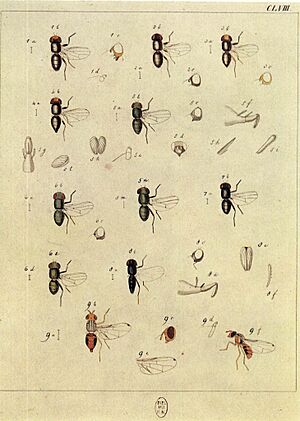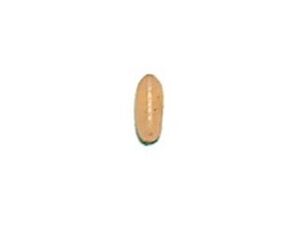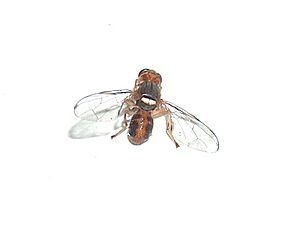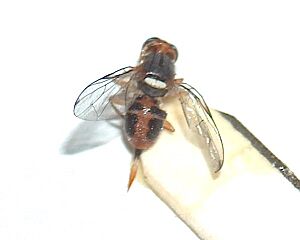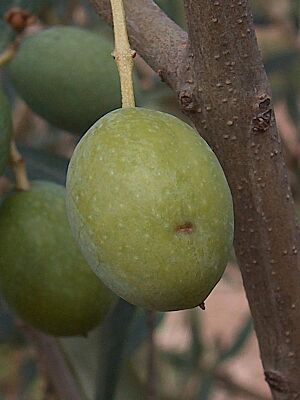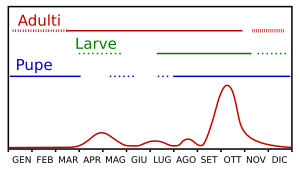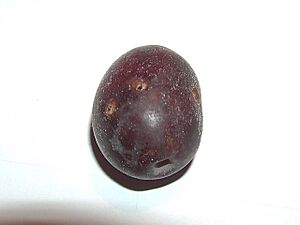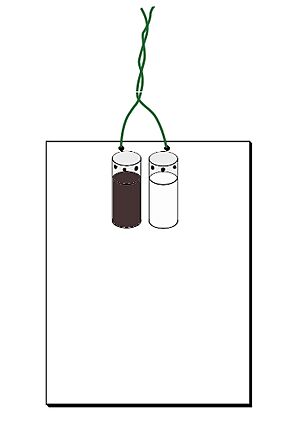Olive fruit fly facts for kids
The olive fruit fly (Bactrocera oleae) is a tiny insect from the fruit fly family. Its young, called larvae, really love to eat olive fruits. This makes it a big problem for olive farmers because it can harm a lot of their olives.
Before 1998, this fly was only found where olive trees naturally grew in the Eastern Hemisphere. This includes parts of Africa, Southern Europe, India, and Western Asia. But then it appeared in California, USA, and has now spread to other areas in North America.
Contents
- Where Do Olive Fruit Flies Live?
- What Does an Olive Fruit Fly Look Like?
- Life Cycle of the Olive Fruit Fly
- What the Fly Needs to Live
- How Olive Fruit Fly Populations Change
- What Makes Olive Trees More Likely to Be Attacked?
- What Kind of Damage Do They Cause?
- Natural Enemies of the Olive Fruit Fly
- How to Control Olive Fruit Flies
- See also
Where Do Olive Fruit Flies Live?
This fly usually lives wherever olive trees grow. It's common around the Mediterranean Sea and in South Africa. Since the late 1990s, it has also spread to California. It is known as the most serious pest for olives in these places. It can greatly affect how many olives are produced and how good they are.
The fly causes more damage in places that are humid and cooler. It also affects some types of olives more than others. This is especially true in areas that have hot summers but less dry weather.
What Does an Olive Fruit Fly Look Like?
The olive fruit fly goes through several stages in its life.
Egg Stage
The egg is tiny, about 0.7 to 1.2 millimeters long. It's shaped like a long oval and is a bit flat on one side. It has a small white bump that helps the baby fly inside breathe.
Larva Stage
The larva is the worm-like stage. It's white-yellowish and grows to be about 6–7 millimeters long. It has a narrow front end. The larva grows through three stages. The first stage larva has only one pair of breathing holes at the back. The second and third stage larvae have breathing holes at the front.
Pupa Stage
After the larva, comes the pupa. This stage happens inside a hard, oval shell called a puparium. The puparium is about 3.5 to 4.5 millimeters long. Its color can change from creamy white to yellow-brown as it gets older.
Adult Stage
Adult olive fruit flies are about 4–5 millimeters long. They are easy to spot because they have a small dark spot at the tip of their wings.
- Male Adults: The male fly has a slightly different wing shape than the female.
- Female Adults: The female fly has a yellowish head with two dark spots near her eyes. Her eyes are bluish-green. Her body can have different markings, but usually, she has dark spots on her abdomen. She also has a part called an ovipositor, which she uses to lay eggs.
Life Cycle of the Olive Fruit Fly
Female flies lay their eggs in the summer when olives are at least 7–8 millimeters wide. The female uses her ovipositor to make a tiny hole in the olive's skin. She then lays just one egg inside the olive. This bite leaves a small, triangle-shaped mark. Fresh bites look dark green, but older ones turn yellowish-brown as the olive heals.
The egg hatches in a few days during summer. It can take up to 10 days in autumn. The newly hatched larva starts by digging a tunnel just under the olive's skin. Later, it moves deeper into the olive's flesh. It doesn't usually reach the pit. As the larva grows, it changes size twice.
When the larva is fully grown (third stage), it moves back towards the surface of the olive. It chews a path to the outside, leaving only a very thin layer of skin. At this point, you can clearly see the damage on the olive, which looks darker. A circular hole appears on the surface where the larva was. The larva then turns into a pupa inside the olive, protected by its old skin.
When the adult fly is ready, it breaks out of the pupa. It pushes through the thin skin left by the larva to escape the olive. In late autumn and winter, the larva might leave the olive and drop to the ground to turn into a pupa there.
Adult flies mainly eat sweet liquids like honeydew. Since this diet doesn't have much protein, they are also attracted to things that smell like protein, such as bird droppings. This behavior is useful for scientists who try to control the flies using special traps with protein attractants.
What the Fly Needs to Live
The olive fruit fly's life cycle depends a lot on the weather and the condition of the olives. Knowing these things helps farmers manage the flies.
Temperature and humidity are very important. Here's how long each stage lasts:
| Stage | Summer | Autumn-Winter |
|---|---|---|
| Egg | 2–3 days | 10 days (autumn) |
| Larva | 10–13 days | 20 days or more |
| Pupa | 10 days | up to 4 months (if it's hibernating) |
| Adults | several months | |
High temperatures (above 30°C) can make it harder for female flies to lay eggs. If temperatures stay above 32°C for many hours a day, over 80% of eggs and young larvae can die. Very cold temperatures (below 0°C) also stop the fly's activity.
The best temperatures for laying eggs and for larvae to grow are between 20°C and 30°C. Humid weather is also good for them.
The olives themselves also play a role. Female flies can sense if an olive is ready for them to lay eggs in. They check the size, color, and smell of the olive. Sometimes, they even make a "test bite" to see if the olive is suitable. This behavior is being studied to find ways to repel the flies.
Larvae grow better in larger olives. This is because they can move deeper inside to escape high temperatures. The type of olive tree also affects how much damage the flies cause.
How Olive Fruit Fly Populations Change
Unlike some other insects, olive fruit flies don't have very distinct generations. Usually, three to five generations are born in a year. Sometimes, a sixth generation can appear in spring, but it doesn't stay on the olive tree.
The number of flies changes throughout the year. There are usually two peaks:
- The first peak is in mid-spring. This is when the adults from the winter generation emerge.
- The second, and bigger, peak is in early autumn. This is when olives are most ready for eggs, and the weather gets a bit cooler and wetter.
What Makes Olive Trees More Likely to Be Attacked?
Several things can make olive trees more likely to be attacked by the olive fruit fly. The weather (temperature and rain) is a big factor. So, the amount of damage can change a lot from year to year. Other factors include the type of olive tree and how it's farmed.
Conditions that favor fly attacks are:
- Moderate heat, with temperatures not going above 32-34°C.
- Humid weather.
- Olives that ripen early.
- Olive trees grown for both oil and eating.
- Olive trees that are irrigated (watered).
Because of these factors, fly attacks are often worse in northern areas compared to southern areas. They are also worse in inland regions compared to coastal ones. Summer infestations are usually small. The biggest infestations happen from September until cold weather arrives, especially if it's rainy.
What Kind of Damage Do They Cause?
The olive fruit fly causes two main types of damage:
- Quantity Damage: The larvae, especially in their second and third stages, eat a lot of the olive's flesh. This reduces how much oil can be made from the olives. Also, many attacked olives fall off the tree early. For olives meant for eating, even the "test bites" can cause damage because they make the olive look bad.
- Quality Damage: Oil made from olives that have been heavily attacked by third-stage larvae is much lower quality. It has a higher acidity level and doesn't last as long. Also, other problems like mold can grow in the holes made by the flies. This is especially true for oil made from olives that have fallen to the ground or were stored for too long before pressing.
Natural Enemies of the Olive Fruit Fly
There aren't many natural enemies that hunt the olive fruit fly. However, the ones that do exist can help control the fly population. These natural enemies are mostly parasitoids. Parasitoids are insects that lay their eggs inside or on another insect. Their young then feed on and kill the host insect.
- Opius concolor: This tiny wasp lays its eggs inside the olive fruit fly larvae.
- Pnigalio mediterraneus: This wasp lays its eggs on the outside of the olive fruit fly larvae. It's very active, especially in summer.
- Eupelmus urozonus: Another wasp that lays its eggs on the outside of the larvae. It has two or three generations in summer that attack the olive fruit fly.
- Eurytoma martellii: This wasp also lays its eggs on the outside of the larvae.
- Lasioptera berlesiana: This is a type of fly that preys on several insects, including the olive fruit fly.
These natural enemies can help when the fly population is small. However, they usually can't stop a very large infestation on their own.
How to Control Olive Fruit Flies
People use different methods to control the olive fruit fly and protect olive crops.
Chemical Control
Farmers can spray olive trees with insecticides to kill the larvae or to prevent adults from laying eggs.
- Larvicide Treatments: These treatments kill the larvae inside the olives. They are often done based on a schedule. For example, if there are too many adult flies caught in traps, or if a certain percentage of olives are already infested with young larvae. Farmers check the olives regularly to see if treatment is needed.
- Preventive Treatments: These treatments aim to kill adult flies before they lay eggs. Farmers spray parts of the olive trees with poisoned protein baits. Adult flies are attracted to these protein baits because they need protein in their diet. These treatments use less insecticide and are better for the environment. Some new baits even use natural insecticides that are allowed in organic farming.
Some substances like copper and kaolin (a type of clay) have also been found to repel the flies. Copper might work by affecting bacteria that live inside the flies. Kaolin might make it harder for females to see the olive's color, which they use to decide where to lay eggs. These methods are still being studied but are good because they are safer for the environment.
Biological and Integrated Pest Management
Biological control uses natural enemies like the Opius concolor wasp. However, this method can be expensive and doesn't always work perfectly.
Integrated pest management (IPM) is a more complete approach. It combines different methods to control pests in a way that is safe for the environment and effective. IPM for the olive fruit fly includes:
- Choosing olive types that are less likely to be attacked.
- Harvesting olives earlier, especially for sensitive types.
- Using insecticides that have a low impact on helpful insects.
- Only using chemical treatments when absolutely necessary.
- Using poisoned protein baits to prevent egg-laying.
- Using repellents like copper-based products.
- Removing all olives from trees after harvest to prevent flies from surviving winter.
- Monitoring weather conditions.
- Using special traps (biotechnical control).
Biotechnical Pest Management
This method uses traps to either monitor the fly population or to catch many flies to reduce their numbers.
- Monitoring Traps: These traps help farmers count how many adult flies are around. This helps them decide if they need to take action. These traps often have a sticky surface.
- Mass Trapping: These traps are designed to catch a lot of adult flies to lower the overall population. This can be as effective as chemical treatments if done on a large scale.
Since the late 1990s, special traps called Ecotraps have been available. These traps use two things to attract flies:
- Pheromones: These are special scents that female flies release to attract males. They are very specific to the olive fruit fly.
- Food Attractants: These are smells that attract flies looking for protein, like protein hydrolysates and ammonium salts.
The Ecotrap also has an insecticide to kill the flies once they are attracted. These traps have shown good results.
Currently, sticky traps are best for monitoring. Traps that combine pheromones and food attractants are best for catching many flies.
See also
In Spanish: Bactrocera oleae para niños


